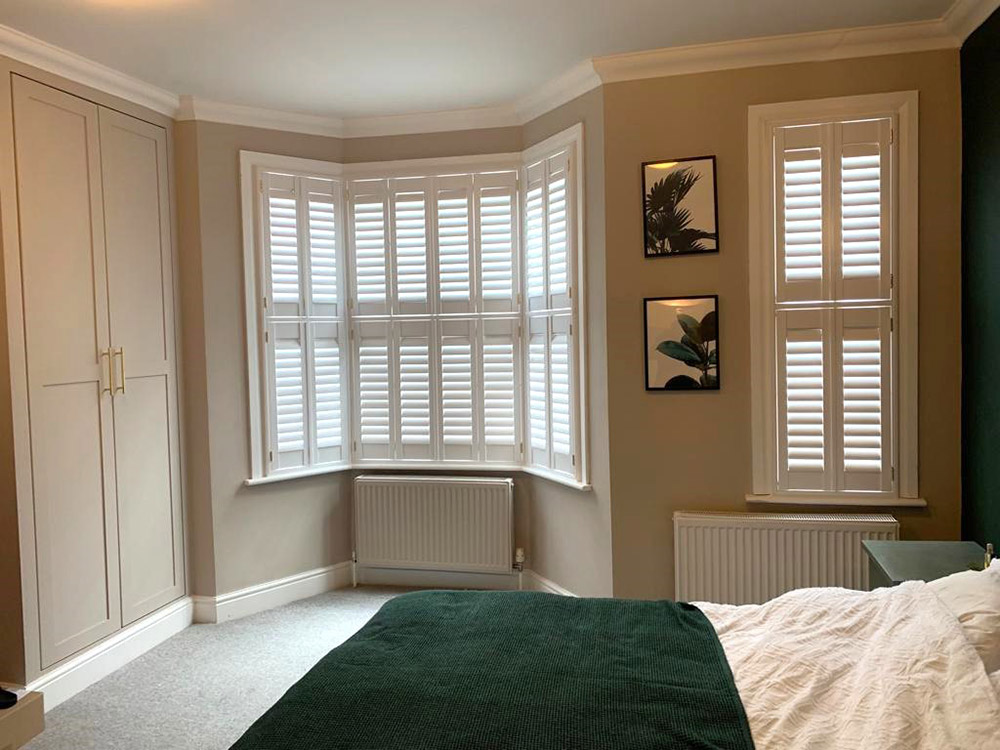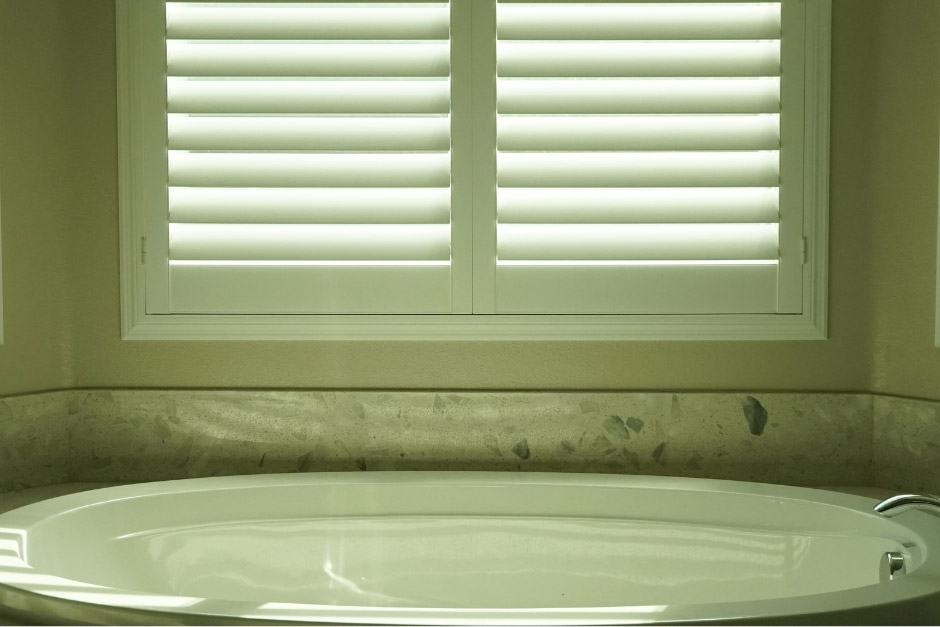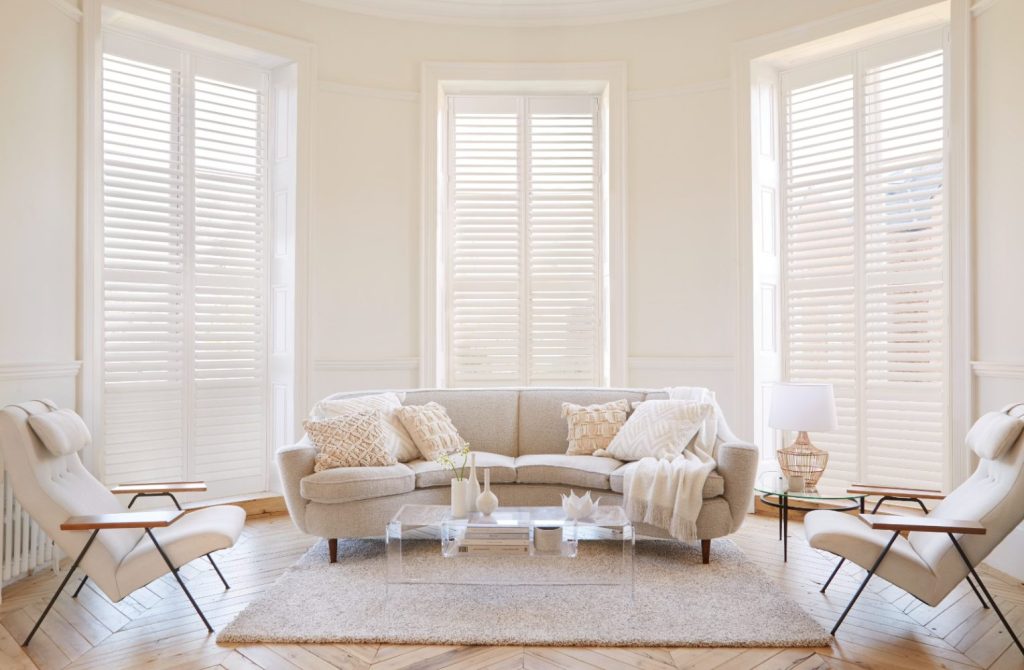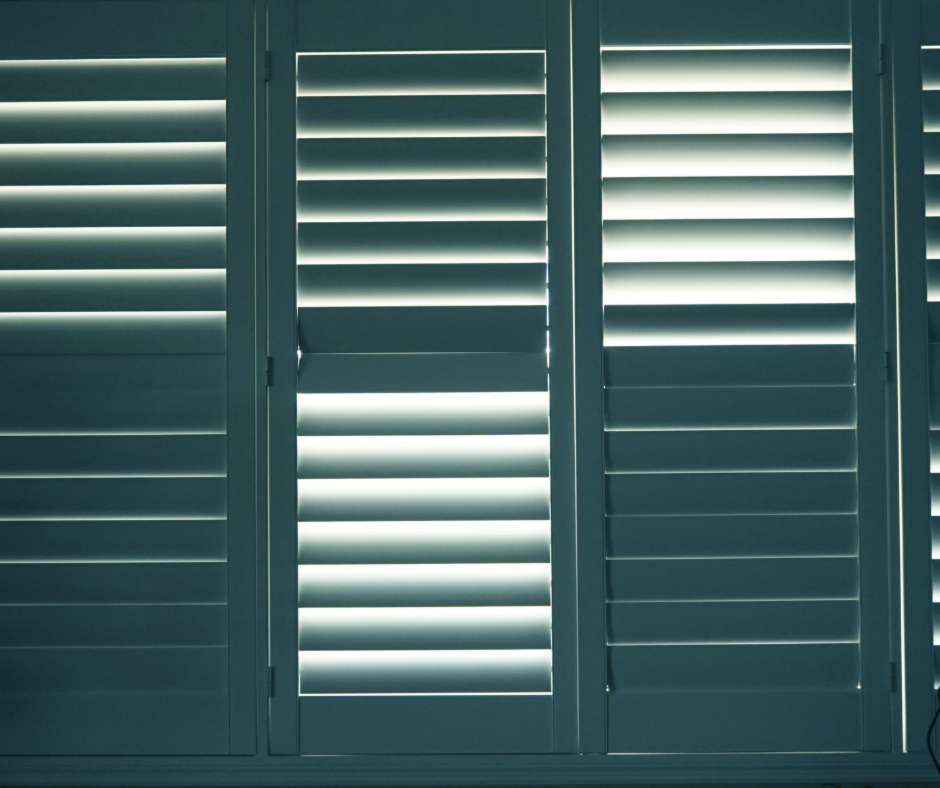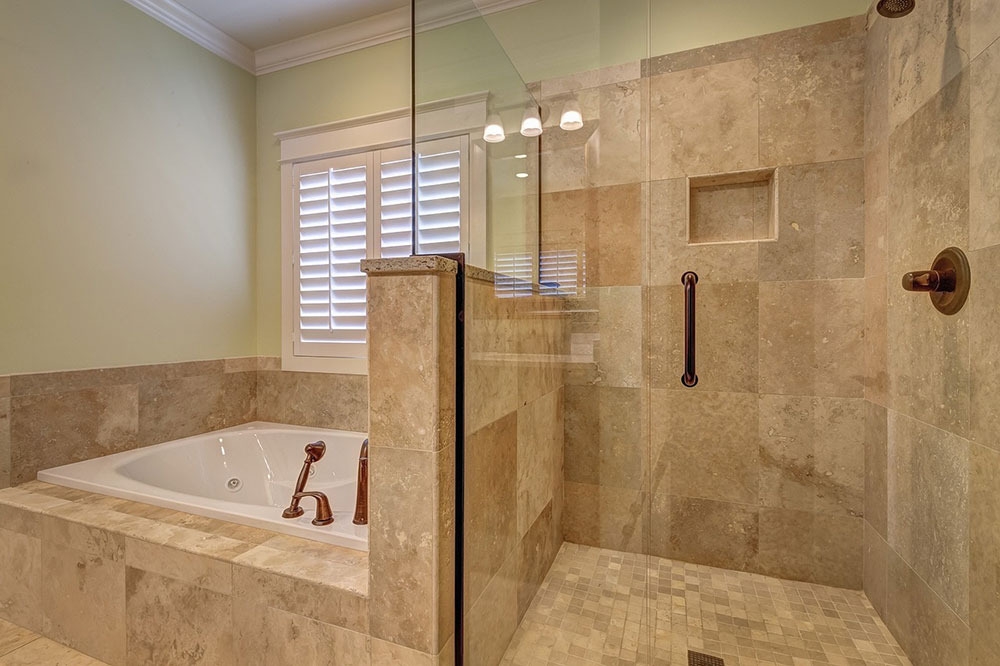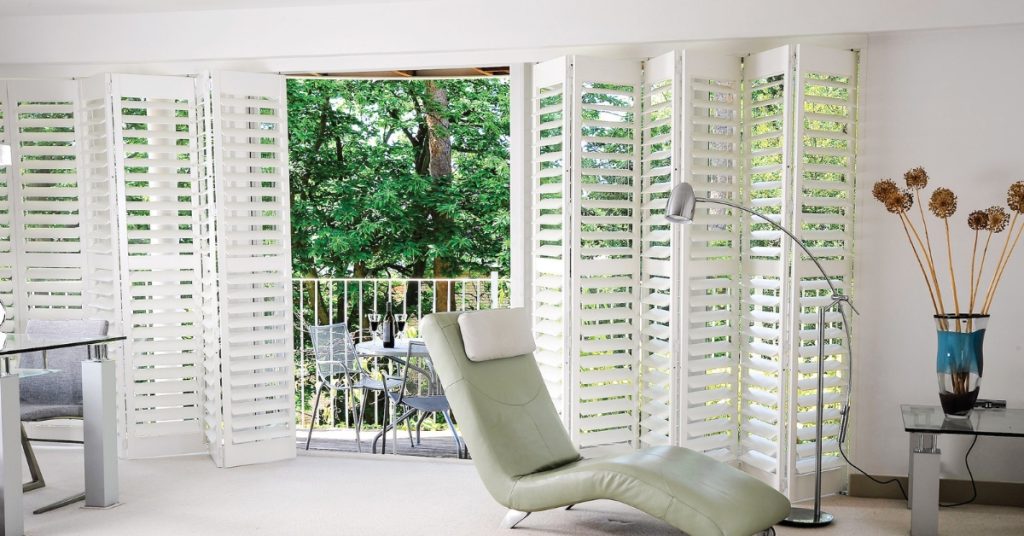Picking the right window shutters isn’t just about blocking out the sun. It’s about getting the light just how you want it, keeping the heat in (or out), and making your home look and feel better – all at the same time.
Unlike curtains and blinds that flap about or get tangled up, shutters are fitted properly, stay put, and do the job day in, day out. They’re easy to use, easy to clean – and let’s be honest – they look pretty good as well.
Get it right, and you won’t just cover your windows. You’ll add value to your home, cut down your energy bills, and actually enjoy your mornings when the sun comes streaming through the slats just so.
Types of Window Shutters
There’s a shutter for every room and every kind of opening – a tiny bathroom or a wide bay window in the front room. Here’s a quick look at the main options.

Window Shutters
The classics. These shutters fit neatly inside your window frame and usually have slats (called louvres) that tilt open and closed. They’re great for everyday use because they give you control over light and privacy at the same time. Use them in just about any room.
Door Shutters
These are made taller and narrower to fit doors (such as French or patio doors) and often have a break in the middle to work around handles and locks. You still get privacy, insulation, and style – in door form.
Blackout Shutters
There are for the light sleepers, shift workers, or anyone who doesn’t want sunlight ruining a good nap. They combine regular window shutters with a blackout blind hidden behind the slats. You get total darkness when you want it and regular shutter function when you don’t.
Solid Shutters
No slats here – just solid panels that open and close like cupboard doors. These are ideal for bedrooms where you want a bit more darkness and insulation. They’re especially popular in older or period homes where the look suits the character of the space.
Bay Window Shutters
Bay windows are beautiful, but they can be awkward to dress. Shutters are a great solution. Each panel is made to fit your bay’s shape so you still get the full look of the window without covering it up with bulky curtains.
Explore all our shutter styles to find the perfect match for your home’s look.
Materials – MDF Shutters vs Wood
This is a very common question that we get asked. Should you go with MDF or Wood? It’s a personal choice, but each one has its perks.

MDF (Medium-Density Fibreboard)
Good for – Most rooms, smaller windows, tighter budgets
- Strong and affordable
- Doesn’t warp easily
- Easy to clean
- Looks almost identical to wood once painted
Not ideal for – Bathrooms, large spans, custom shapes
Because MDF plantation shutters are heavier, they’re not always the best fit for wide or tall windows. It also doesn’t lose moisture, so avoid using it in steamy bathrooms.
Wood
Good for – Larger windows, custom designs, those who want a natural finish.
- Lighter than MDF
- Easier to shape for curves or unusual windows
- Available to paint or stain finishes
- It can handle bigger sizes without sagging.
Not ideal for – Lower budgets or very damp rooms
Wood gives you more choice in finishes and design, but it costs more and takes a little extra care to keep looking good.
We go into more detail about this in our MDF vs Wood Shutters Guide if you want the full picture.
Window Shutter Costs: What Can You Expect to Pay?
Prices vary based on your choices, but here’s a rough idea.
- Small window – around £250
- Medium window – about £450
- Large or bay window – from £650 and up.
The total cost depends on:
- Window size
- Number of panels
- Material (wood is pricier than MDF)
- Style (tier-on-tier and special shapes cost more)
- Optional extras like hidden tilt rods or custom colours
Remember, Interior window shutters are custom-made and fitted. They last for years, so you’re not just paying for looks – you’re getting long-term value.
For more detailed info, head over to our shutter cost breakdown.
Choosing the Right Window Shutter Style for You and Your Home

The best shutters for windows aren’t just about what fits – they are about what fits you.
It depends on two things.
1. The type of window or room you’re working with.
2. The look you’re going for (modern, classic, or somewhere in between).
Let’s break it down so you can make sense of what works – and, just as importantly, what doesn’t.
Start With Your Windows and Rooms
Not all windows are created equal. Some slide. Some swing. Some are set into a beautiful bay. Others are awkward shapes that clearly weren’t designed with shutters in mind – but we can still help work out the best shutters for windows. Here’s how to look at it.
Sash Windows
These are the vertical sliding windows you’ll find in many period homes, especially around London, where we work. They look great with tier-on-tier shutters, which mimic the design of the sash itself. You can open the top section for light, keep the bottom closed for privacy, or mix and match as you like.
If you don’t want to overcomplicate things, then full-height window shutters also work well – just make sure they’re designed with a mid-rail that lines up with the sash window’s horizontal bar. That way, it all looks intentional.
Bay Windows
Ah, the bay window. Beautiful to look at, awkward to dress – until you find shutters. Because each section of the bay can be shuttered individually, you get complete control without blocking the shape of the window.
Cafe style works well if you want to keep the upper part open and flood the room with light. Full-height shutters are great if privacy is a priority or if your bay faces the street.
French Doors and Patio Doors
For doors, full-height shutters are your best bet. They’re tall, tidy, and usually designed with a mid-rail to line up with the handle. That way, you can still open the door without fighting the panels. Some designs even allow for cut-outs where the handle sits, so everything is just right. You can explore more options in our shutters for French and patio doors guide.
Bathrooms and Kitchens
In humid rooms, go for window shutters made of waterproof materials or designed to handle moisture. Cafe style is ideal above a kitchen sink – it gives you light up top and privacy below while keeping things splash-friendly. In a bathroom, full-height shutters with a durable finish work best. You get privacy, light control, and no soggy curtains to deal with.
Bedrooms
If you value sleep and hate early morning sunlight, full-height shutters are the go-to. Add a blackout blind behind if you’re particularly light-sensitive. For a softer, period feel, solid shutters are also a great choice – they block light completely and give the room a cosy, shut-the-world-out feel.
Match Your Style – Modern, Traditional, or Minimalist?
Once you’ve sorted out the practical side, it’s time to think about looks. Shutters for windows are a long-term fixture, so you’ll want something that fits your home’s vibe. Here’s how to match the style to your decor.

Modern Homes
Clean lines, simple finishes, neutral tones – if this sounds like your place, you’ll want interior window shutters that suit it.
- Go for wide slats (89mm is a popular size). They let in more light and feel less fussy.
- Opt for a hidden tilt rod, so there’s no vertical bar showing in the middle.
- Stick to solid whites, greys, or taupes. Match your shutter colour to your window frame for a clean, built-in look.
- Choose full-height panels with no mid-rail if possible (unless your window requires one). It’s tidy, simple, and suits a modern home.
Traditional or Period Homes
If you’ve got cornicing, fireplaces, and original wood floors, shutters can add to that charm rather than clash with it.
- Tier-on-tier shutters feel right at home here. They suit sash windows and look like they’ve been there forever.
- Small louvre sizes (63mm or 76mm) look more classic than the wide, modern ones.
- Central tilt rods can actually improve the look – think of them as part of the design rather than a distraction.
- Creams, off-whites, or even a painted wood finish (if your walls allow) work really well in traditional homes.
- If you want to go even more heritage, solid panel shutters are the real deal. These were standard before louvered shutters became popular, and they’re perfect for bedrooms or formal sitting rooms.
Minimalist Interiors
If your design theme is all about “less is more”, shutters are going to be perfect for you – especially window shutters that replace both curtains and blinds in one go.
- Choose hidden tilt rods and a uniform colour scheme.
- Stick to one style throughout the house to avoid visual clutter.
- Go for large slats and clean frames.
- Avoid decorative extras – let the shutters blend in and quietly do their job.
Bold or Eclectic Homes
If you’ve got bold wallpaper, statement art, or brightly coloured walls, your shutters don’t need to disappear – they can join in.
- Ask about our custom colour options and colour matching so you can match your colours with other elements of the room.
- Black shutterts in a monochrome scheme? Yes please.
- Soft pastels for a kids’ room? Sounds great.
- Just make sure you love the colour, as shutters aren’t something you’ll change every year.
A Quick Word on Slat Size
It sounds like a small detail, but the louvres (slats) size can really change the look.
64mm (2.5 inch) – Classic and traditional.
76mm (3 inch) – A good all-rounder.
89mm (3.5 inch) – Modern, clean, and lets in the most light.
100mm (plus) – Bold, contemporary, and less common but great for big windows.
Light Control, Privacy & Insulation Benefits
This is where window shutters earn their keep – and then home.

Light
Let’s start with light. With shutters, you’re not just stuck with all or nothing like you are with curtains. You can tilt the slats just enough to let a bit of morning sunshine in without blinding yourself, or angle them to bounce the light off the ceiling and brighten the room more gently. If you want the room dark, close the slats or shut the panels entirely. You’re in charge of the mood any time of day.
Privacy
Now, let’s talk about privacy. Shutters make it easy to block out unwanted views without turning your room into a cave. You can angle the louvers so nobody outside can see in while you get a nice bit of daylight. Great for street-facing rooms, nosey neighbours, or anyone who’d rather not be on display while they try and eat their toast.
Insulation
Then, there’s insulation. Window shutters create an extra layer between your room and the outside world. In winter, that means keeping the warmth in and the drafts out. In summer, they help block the heat as it comes through the glass. The result is a more comfortable home year-round, with less need to crank the heating or switch on the fan.
Want to dive deeper into how shutters can reduce heat loss? This blog post on heat loss and plantation shutters breaks it down further.
Oh, and as a bonus, they also help with noise and furniture protection. Closed window shutters can muffle traffic sounds and reduce fading on fabrics and flooring from harsh sunlight. They’re doing more than you’d think, just by sitting there looking good.
Cleaning & Maintenance Tips
The good news is that shutters are some of the easiest window treatments to maintain.

There’s no need to take them down, wash them, or book a professional cleaner. All it takes is a regular bit of care. A quick dust (once a week) – using a microfibre cloth or soft duster – will stop dust from building up on the slats. Just tilt them open and give them a once-over, top to bottom. Job done.
If something’s splashed or a little stick (hello, kitchen windows), grab a damp cloth with a touch of mild soap. Wipe gently, and they’ll be spotless again in seconds. Don’t go soaking them, especially if they’re wood, and steer clear of harsh chemicals – there’s no need for bleach or anything fancy.
Every now and then, it’s worth checking the hinges or tilt rods. If a screw feels a bit loose, it usually just needs a quick tighten with a screwdriver. It takes seconds and keeps everything working as it should.
Another tip: Open and close your shutters gently. They’re sturdy, but theres no need to yank the slats or swing the panels too far. A light touch keeps everything in good shape for years.
For more handy advice, check out our complete guide to caring for shutters – it’s full of practical tips to help your shutters stay in top condition.
That’s it – no drama, no special tools. Just a bit of regular attention will keep your shutters looking as nice as the day they were fitted.
Final Thoughts on Window Shutters
Window shutters are one of the best things you can add to your home. They add instant style, help with insulation, and give you more control over how your home looks and feels.
The key is knowing your space and picking the right style and material to suit it. Hopefully, this guide has made that easier and even given you some inspiration.
Ready To Get Started?
If you’re unsure which style will suit your home, browse through photo galleries, ask us for some samples, or book a consultation. Seeing shutters in real homes (not just showrooms) can also help you imagine them in your space.
Better yet, chat with us as we install them on houses like yours every day. We will be able to advise you on choosing the right shutters and what works best with your windows and rooms, avoiding styles that sound good on paper but don’t work in reality.
Let’s make your windows look amazing.




